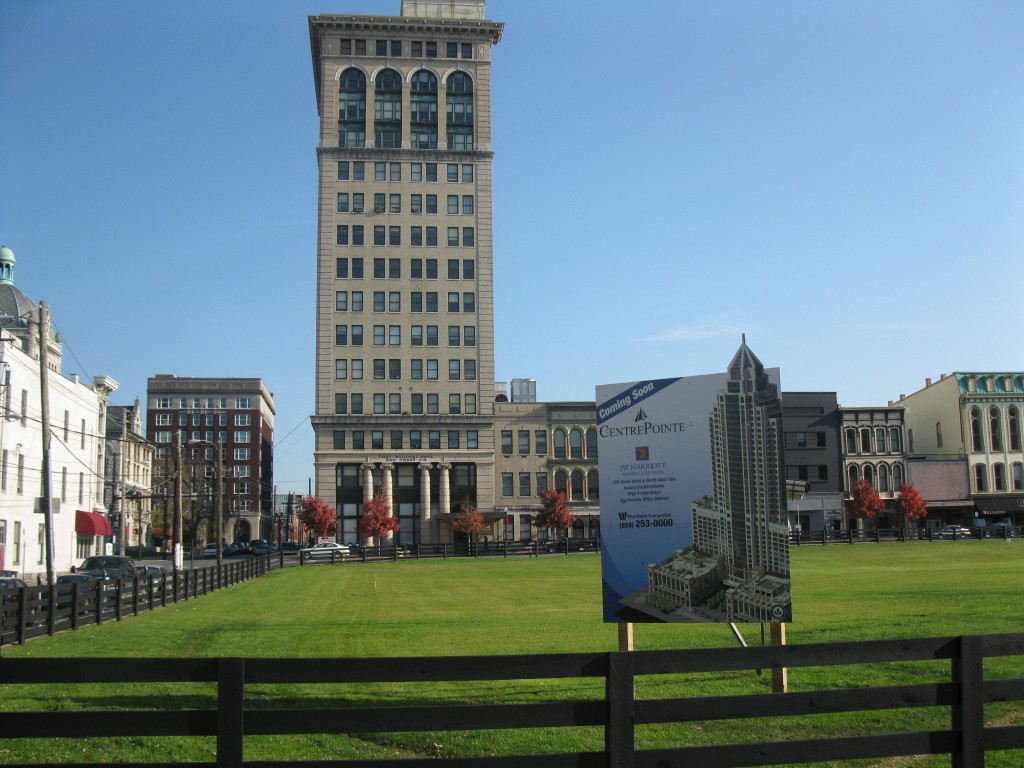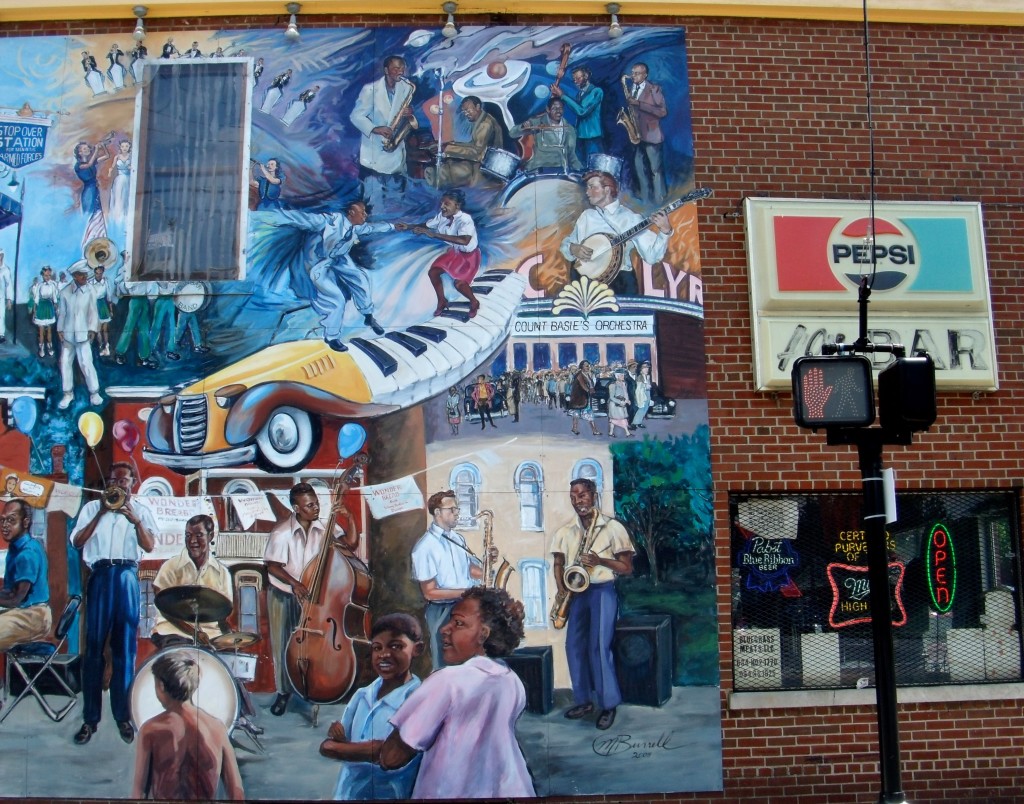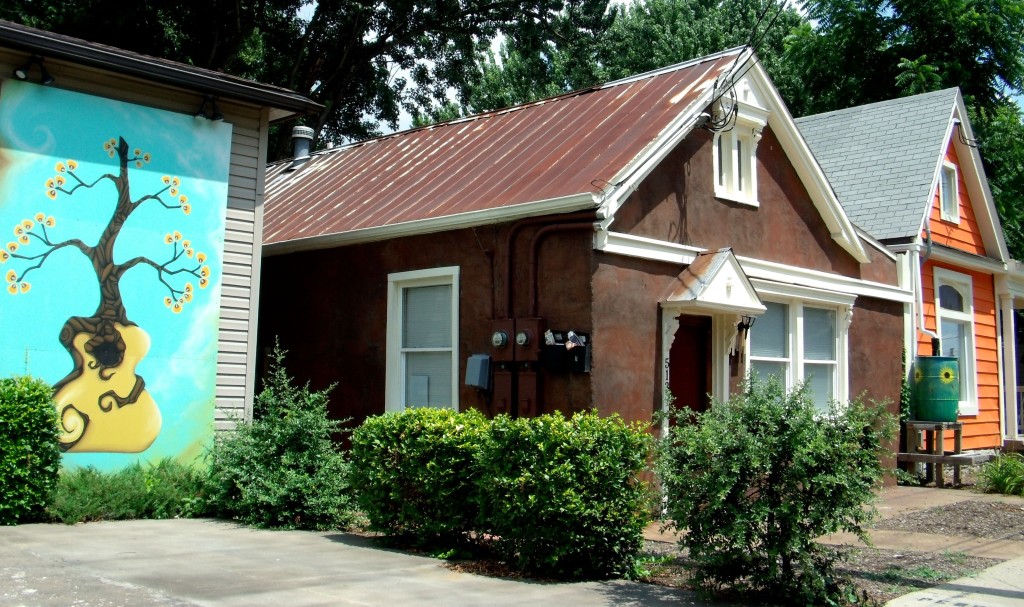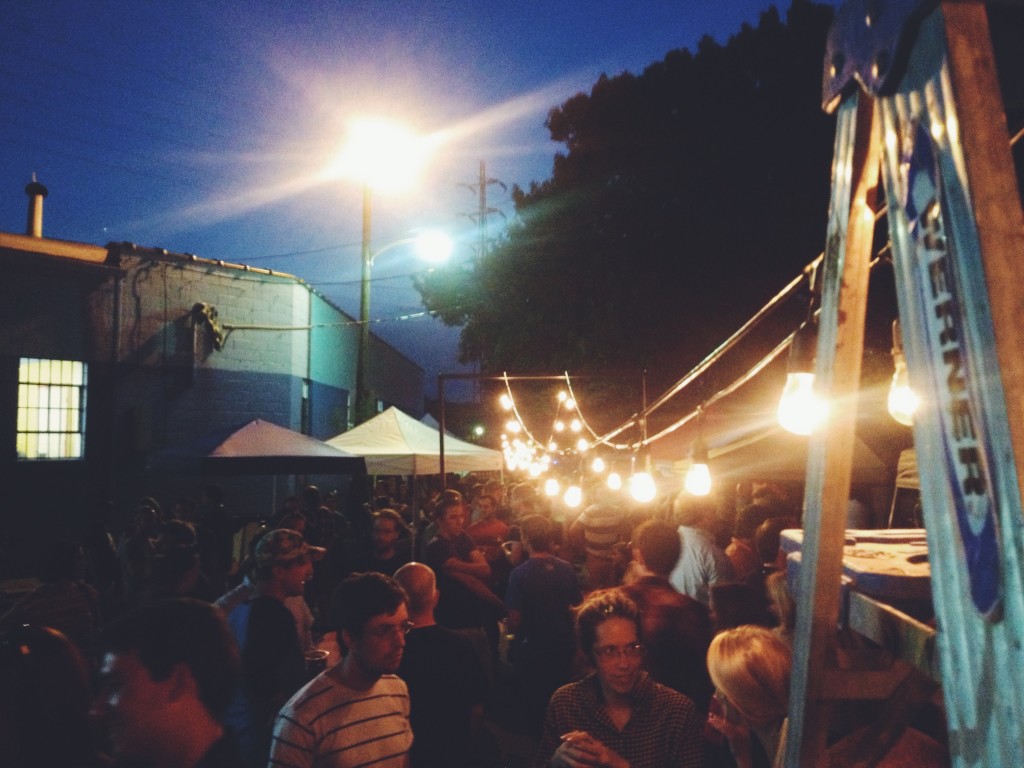by Bianca Spriggs
In 2008, stunned Lexingtonians watched helplessly as what is now affectionately remembered as “The Dame Block,” was being demolished to make way for the new CentrePointe complex. Bound by West Main, West Vine, South Upper and South Limestone streets, the buildings on this formerly beloved block housed The Dame, The Mad Hatter, Mia’s, Buster’s, and yes, even Royal Crown Lounge. I spent the best years of my twenties on “The Dame Block” where the music was good, the drinks and cover prices cheap, and the camaraderie abundant. It felt like half of Lexington was on those sidewalks on a summer weekend as the 80s dance-party music from The Dame overlapped with the sound of hard rock and clacking billiard balls from Buster’s. Sometimes, we literally fell out of one establishment to land in the other, ending up at Mia’s for late night appetizers.

And then it was over. In a lot of ways, it felt like a friend had died. The block was slowly, torturously razed and a fenced-in pasture took its place for the next five years. In case you haven’t been downtown recently and heard or felt the demolition blasts, construction only began a few months ago on CentrePoint, despite original plans to have been finished by the 2010 Equestrian Games. At the time, around downtown Lexington, there were signs of other establishments popping up here and there like Stella’s and Al’s Bar, but when “The Dame Block” bit the dirt, like little mushrooms and foliage sprouting from the great fallen oak in the forest, new business owners began erecting other options for nightlife entertainment. And before you could say the words, “Flipped it!,” urban overhaul was upon our fair city.

I have often viewed Lexington as a microcosm of the rest of the nation particularly when it comes to trends in real estate. We’re considered an educated city, and with a recent influx of young professionals, we’re also a new business-owner’s wet dream. To this day, when it comes to buying and renting property, the price tag is key, and in downtown, cheap property is abundant. Dilapidated spaces are snapped up, renovated, then re-sold or rented. Recent college graduates rather than moving out of town, have stayed, and are filling up the North-side and East-end residences, where they are able to work, shop, and party downtown. Young entrepreneurs are able to start dream businesses in these areas and innovative investors invite public art and artistic home improvements to attract burgeoning families who want to buy their first starter-kit home, as well as single folks who are happy to rent in smaller, conveniently located residential areas. So, what are the implications for all of this new activity downtown? On the one hand, you get microbreweries, bars, restaurants, and cafes, and safer neighborhoods, but on the other hand, the faces are literally changing in downtown and becoming noticeably, well, whiter.
The “G” Word
Any expanding city groans through its share of growing pains. Molly Crain, an up-and-coming young activist who spent time working on Elisabeth Jensen’s campaign, lived on Fifth and Broadway while attending Transylvania University. Going out of her way to at least speak to her neighbors and insisting on walking to campus in order to feel like she was part of her community, in 2012, Crain wrote her senior thesis on gentrification in Lexington, focusing a good deal on the history of how property changed hands here, the current racial demographics of the streets, and “hidden narratives” of residents who negatively experience gentrification.
 Merriam-Webster defines “gentrification” as “the process of renewal and rebuilding accompanying the influx of the middle class or affluent people into deteriorating areas that often displaces poorer residents.” It’s also worth noting that the earliest known use of the word was in 1964. Crain’s research in Lexington led her to discover that many of the current changes that Lexington is now experiencing were set into motion in the 1970’s with the creation of one-way streets. More recently, however, instead of moving commuters in and out of the city as expediently as possible, urban planners are looking for ways to move people back towards the center.
Merriam-Webster defines “gentrification” as “the process of renewal and rebuilding accompanying the influx of the middle class or affluent people into deteriorating areas that often displaces poorer residents.” It’s also worth noting that the earliest known use of the word was in 1964. Crain’s research in Lexington led her to discover that many of the current changes that Lexington is now experiencing were set into motion in the 1970’s with the creation of one-way streets. More recently, however, instead of moving commuters in and out of the city as expediently as possible, urban planners are looking for ways to move people back towards the center.
Crain recalls the looks on the faces of some of her interviewees as she researched her thesis when she dropped the word “gentrification.” Often viewed as a pejorative term, gentrification calls to mind wealthy developers who are only interested in the bottom line. There are certainly current property-owners in Lexington who have contributed to this perception of gentrification, particularly in the East End—one in particular has even garnered the reputation as the “Cruella de Vil” of downtown and is known for snatching up practically whole streets of residences, poorly flipping the homes, and ostracizing current tenants. It also doesn’t help that most of these investors are white and their properties are located in black neighborhoods. To claim that you’re a gentrifier is in a lot of ways, social suicide. It’s no wonder in order to spin a more positive light on gentrification, well-intentioned investors, business owners, and the media tend to use the much more benign phrase “urban renewal” instead, which is defined as “a process by which old buildings or buildings that are in bad condition in part of a city are replaced or repaired.” And while the definition “gentrification” emphasizes class and “urban renewal” is a much broader term focusing on the act of building repair, the two are in many ways inseparable from race because of a) who is doing the rebuilding and b) where the replaced structures are located.
Like many American cities, Lexington experienced its share of what is known as “white flight” where in the mid-twentieth century, white middle-class residents exchanged urban regions for suburban areas. But before “white flight” Molly Crain, who describes herself as obsessed with the causes and patterns of gentrification, explains that Lexington’s antebellum downtown was originally occupied by wealthy white citizens with blacks settling in “urban clusters called enclaves, intermingling with the white population.” Already a city noted by scholars as “the central location for the national slave trade despite Kentucky’s neutrality,” Crain discovered that as their population increased in the 19th century, blacks originally settled on the periphery of established white communities.
In the mid-twentieth century, many white residents left downtown, exchanging it for the suburbs, leaving these properties open to populations of people of color. For generations, blacks have rented and owned housing throughout downtown Lexington but within the past five years, the return of white middle and upper-class residents to the city’s center has created mixed sentiments between new neighbors of vastly varied socio-economic statuses, complicating formerly straightforward definitions with the messy politics of race relations. There are those who believe that urban renewal is a positive and long overdue force in Lexington and some who believe the only difference between it and the negative interpretation of gentrification is in the spelling. What everyone so far can agree upon is that nothing about the revitalization of businesses and interest in home-ownership in downtown Lexington is clear-cut.
Meet the Neighbors
Every week since June 2012, droves of neon running shoes pound the pavement along Jefferson Street from Sixth to Main and beyond. Rivulets of runners from the West Sixth Running Club make their way up one of the longest residential streets in downtown Lexington as residents sit on their porches and watch them stream by the houses, many of which are in the process of being renovated. Construction is constantly going on one side of the street or the other and even on weekdays, the cramped street lanes are crammed further with vehicles, trolleys, food trucks, parked cars, cars racing by, or cars slowing to a crawl to find parking, all amid which carefree pedestrians merrily risk life and limb to jaywalk across traffic to their respective destinations. Over the past five years, like the North Limestone Street area, Jefferson Street has become a hotbed of growth in downtown Lexington, attracting real estate investors and business owners who are lured by inexpensive properties and the increasingly bustling dynamic of the street with several restaurants and bars now nestled in-between homes.

Link Henderson, owner of Kentucky Mudworks, LLC, a teaching studio and production pottery studio, remembers when “J-Street” looked and felt much differently during her tenure of working and living there from 2003-2006. Back then, when The Green Lantern was called The Hideaway, Henderson rented a space that doubled as a storefront and studio and later her apartment and recalls that “All those fancy restaurants were rehab houses.” Rattling off stories about neighbors who were primarily white, “nighttime creepers and pimps and meth-heads,” Henderson asserts that it took someone like her, “a bad-ass southern girl and her mean-ass dog, and an alarm system,” to trail-blaze Jefferson.
Henderson moved to Lexington in 1999 and says that back then, ”Lexington was a pathetic, sad downtown—at 4:59 they locked up and turned the lights off.” The Jefferson Street that Henderson remembers was split by an invisible line dividing white and black residents right around Third Street. On her end of “J-Street” Henderson remembers squat brick houses were crammed with residents who proudly flew their Confederate and “Git ‘er dun” flags, chained up their dogs, and often held rowdy BBQs in the front-yards. Every weekend you’d hear gunshots, squealing tires, and see cars dropping off women at all hours of the night.
To Henderson, urban renewal is a government word, something politicians use. For her, urban renewal over the past fourteen years is a result of customers demanding something to do in a downtown area. Although she’s since moved out to a farm in Lawrenceberg, Mudworks is currently located on National Avenue (which is undergoing its own surge in development), but her connection to downtown Lexington stays strong, particularly given her profession as an artist, “Part of me is a little jealous. I love seeing people putting money into preserving old buildings. Now, it’s pleasing to come downtown.” She enjoys seeing houses that were previously standing as empty shells having patios and color added, lending diversity to the architecture. But in exchange for becoming beautiful, Henderson reflects that “J-Street” has “lost its grit.”
Currently living on Jefferson Street are a well-known black couple, Kenneth and Sonja Brooks, who have resided there for eleven years. Before that, the Brookses lived on Short Street above their art gallery, the Heritage Art Center, which has been in operation since 1998, but they’ve owned the building since 1996. In terms of how she views all of the more recent activity in her neighborhood, Sonja Brooks admits, “Sometimes I’m not even sure which way to go. I can see this point of view; I can see that point of view. It’s not simple at all.” She describes how the streets in downtown tend to overlap in terms of economic status divided between home-owners and renters, “Downtown is wild. You have the rich block, then the poor block, the rich block, the poor block.”
In terms of their tenure on Jefferson Street, Brooks thinks about ownership. Having been surrounded for the most part by renters, in the last six or seven years, a number of the homes have been purchased with many of the owners moving in, although some people renovate and are content to continue renting which preserves the diversity of the street, “That’s one thing about Jefferson, to me, that’s a contrast to Short Street. Jefferson is changing a little, but it’s a little more diverse and easier-going than Short Street where people are a bit more monied, I’d say, as far as the residential homes.” For Brooks, Jefferson has still got some variety and diversity, particularly around the three-hundred block which hasn’t really yet been susceptible to commercial or store property to cause the same degree of change, but she observes that it’s definitely heading in their direction from both ends.
She reflects that a number of the adjacent properties around their home have been bought and rented out by Dixon Electric since they’ve lived on Jefferson. “I don’t have a problem with him; he’s actually a nice man, and he’s hired people from around here, and he’s a decent guy, but still, he’s a business guy and if he can buy enough properties here, he could own half the street…on this side.” And although Brooks reflects that the owner of Dixon Electric makes beautiful renovations, in the future, potentially all of those buildings could come down. Still, the Brookses have no intention of moving or selling their home despite the fact that pressure to sell homes has become more aggressive, particularly on the Sixth Street end of Jefferson.
On the far end of Jefferson Street on the corner of Sixth, the Bread Box formerly a Rainbo Bread factory, is now home to a number of thriving businesses and organizations including most obviously, West Sixth Brewing, as well as FoodChain, Smithtown Seafood, Broke Spoke, Cricket Press, Magic Beans Coffee Roasters, The Roller Girls of Central Kentucky, Bluegrass Distillers, and a dozen artists who work in the old factory offices, including myself. The building is so vast, there’s plenty of room for further development on multiple floors, and much work has gone into acquiring the talents of Kentucky craftspeople and artists to beautify the space. On the Bread Box website, the genesis of the organization began as the intent to open a craft brewery “that had a local flavor and positive community impact.” The building and neighborhood proved to be attractive to the owners, Ben, Brady, and Joe, and they decided to change gears by allowing the brewery to become the “anchor tenant that also attracts other organizations to come in and multiply the energy and community benefit.”
To Sarah Williams, a former nurse and current graduate student, and whose parents live on Bellaire Avenue—the street that runs parallel to the Bread Box parking lot—the building may as well be the poster-child for gentrification in the disparaging sense, “My parents have lived on Bellaire my entire life. Gentrification of our neighborhood has changed our quiet ‘dead-end’ street with diverse families into a gathering place for people I have never seen in thirty-two years in my neighborhood.” Sarah observes that the houses are now being renovated and sold at prices far beyond anything people who currently live there can afford. “My parents’ property value rising is not an added bonus when they are retired on a fixed income.” She notes that developers have been particularly aggressive in her neighborhood, trying to convince home-owners to sell. And she is doubtful that the new owners will go out of their way to rent to minorities, “And the clincher—these invaders of my neighborhood look at me like I don’t belong.”
As far as the popular programming such as the free running club and yoga class sponsored by West Sixth throughout the week goes, to Sarah, the cars lining the street invade her family’s privacy and quiet and prevent her family from parking their vehicles on the street, particularly on a weekend. She states that her parents feel that everything they’ve worked for their entire lives along with their quality of life is now being threatened. Williams considers gentrification to be indirectly racist and to say that gentrification is purely economics still involves race, “Facts about the differences in economic prosperity and opportunities between minorities and whites have persisted throughout history and its roots still feed the culture of America…you cannot separate the issues of class and race. Only in a white world is that possible. As a minority, the two are forever an intertwined experience of systemic disenfranchisement.”
Williams, whose father drove a delivery truck for Rainbo Bread, is doubtful that the two realities, between whites and people of color, will ever be able to merge because perception is everything, “From their perspective, they came in to help and are cleaning up. Coolavin is just right down there. The ridiculous amount of crime that’s gone on over there wasn’t addressed and wasn’t an issue until they moved in.”
Across downtown in the North Limestone Corridor, historically one of the more well-trafficked areas for criminal activity in Lexington, is now popularly referred to as the “NoLi” area. NoLi is now viewed as a blossoming business, organizational, and arts district, home to Al’s Bar, Fleet Street Hair Shoppe, Supreme Service Barber Shop, North Lime Coffee & Donuts, Duncan Park, Arcadium, the Lexington Art League, the Living Arts and Science Center, LTMS, Sayre School, the Night Market, Minton’s, and Charmed Life Tattoo. The NoLi CDC, a non-profit community development corporation lists a comprehensive description of the area’s history and a statistical compilation of current demographics, housing and transportation rates. On their website, the organization claims to embrace diversity and was organized to offer affordable housing, coordinate cultural programming, enhance public spaces, grow retail nodes, increase access to social services, and address threats to neighborhood resources.
A house on the corner of Loudon and Maple was the first place Natalie Cunningham, originally of Versailles, moved into upon her arrival in Lexington in 2010 with a group practicing neo-monasticism that emphasizes loving and taking care of one’s neighbors and opening up the doors to create an authentic community relationship. Cunningham recalls being welcomed to the neighborhood as she and her roommates were moving in, by a neighbor, who wanted to know in blunt, colorful language where they came from. While Cunningham, who is the current Community Engagement Coordinator for The Morris Book Shop and has since moved to Ohio Street, feels that because she is of a certain economic status, she benefits from gentrification.
For Cunningham, urban renewal starts with people who live in a certain community wanting their neighbors to be safer, to fix up their neighborhoods. These are people who pursue grants from the city to make improvements in their own communities without the motivation of kicking people out to take advantage of cheap properties and economically depressed tenants. But she admits it’s still complicated, particularly with the influx of properties targeted towards young professionals like herself, “Growing up a certain way, no matter what your intentions are, you’re still trying to create a place for your family based on those standards. You may mean well, but if you’re an investor, you still have to consider money. The ultimate goal is your family and making sure your investments turn out right.” Alternatively, Cunningham wonders how to get rid of the “us vs. them” mentality without generations and generations of people living together.
Tanya Torp may just have the answer. Torp, a well-known local activist and public speaker, who recently bought a house with her husband on Elm Tree Lane, feels that urban renewal is inclusive, “The new neighbors become part of the fabric of what is already there. Urban renewal doesn’t look like one race, or disjointed, or poor people being sacrificed.” Their house is known among their friends as Justice House. For Torp, gentrification tears the fabric of the community and some of the causalities include the oral histories of elders in the communities along with people being displaced who used to feel like family. She feels that there is a loss of the sense of community that felt more about the people and less about the structures, “Call me crazy, but I want to know my neighbors.”
In terms of displacement, Torp observes that minorities who are edged out of downtown are now taking up residence wherever they can afford it, with pockets of affordable housing concentrated in Woodhill and Tates Creek. Additionally, and to the neighborhood’s detriment, Torp doesn’t see many of these new businesses hiring people in the community. She wishes more business-owners were more like Ouita Michel who is strategic and intentional about training and hiring people from the community who are then able to make a living wage, therefore investing back in their neighborhood.
For Torp, conscientious intentionality is the key to successful urban renewal and conversation with one’s neighbors is crucial, “If I could speak to developers, I’d say, “What kind of community do they want to live in? And if it’s in my community, what can we do to make this our community?” And to Torp, shying away from the word “gentrification” is not going to solve much. She encourages people to understand that they are walking into a room with their privilege and that to seek out the champions in the communities of the under-served, “We have to be willing to be uncomfortable. We have to start talking to people who don’t look like us. I have so much respect for some of the people that are called ‘gentrifiers’ but talking to them is uncomfortable. I want to ask, ‘Why aren’t you hiring my neighbors?’…It’s not about race all the time, but that does play a key role.” Ultimately, Torp advocates empowering oneself with knowledge about one’s resources so as not to allow a select group of people with strictly financially-based motives to withhold information and dominate a community.
This article also appears on page 6 of the July 3, 2014 print issue of Ace.
Subscribe to the Ace e-dition for Lexington news, arts, culture, and entertainment, delivered to your inbox every Thursday morning.










